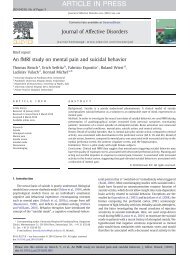Editorial
You also want an ePaper? Increase the reach of your titles
YUMPU automatically turns print PDFs into web optimized ePapers that Google loves.
<strong>Editorial</strong><br />
Will New Insights Into Neural Networks<br />
Help Us to Improve Our<br />
Models of Suicidal Behavior?<br />
Konrad Michel<br />
University Hospital of Psychiatry, Bern, Switzerland<br />
Suicide is a complex phenomenon, and we have learnt that<br />
there is no simple cause–effect relationship that can explain<br />
why people take their own lives. However, in recent<br />
years research has provided us with new insights into biological<br />
and psychological mechanisms related to suicidal<br />
behavior. In a recent Crisis editorial, Kees van Heeringen<br />
(2014) gave a fascinating overview of brain imaging studies<br />
of suicidal behavior. Suicidal behavior is associated<br />
with structural changes in cortical areas of the brain. For<br />
instance, there is an intriguing study by Benedetti and colleagues<br />
(2011) who, in patients with past suicide attempts,<br />
found reduced gray matter volume in the dorsolateral prefrontal<br />
cortex, orbitofrontal cortex, anterior cingulate, and<br />
the basal ganglia – and that lithium treatment reversed<br />
the loss of volume in these areas. Besides cortical abnormalities,<br />
white matter abnormalities have been reported<br />
(Mahon, Burdick, Wu, Ardekani, & Szeszko, 2012). van<br />
Heeringen argues that in order to understand the neural<br />
correlates of dysfunctional cognitive-emotional processing,<br />
we need to go beyond simple structural brain abnormalities,<br />
and focus on networks that connect frontal cortical<br />
areas, including the cingulate cortex and subcortical<br />
areas. The rationale is that connections and networks may<br />
provide the key to the understanding of the neural and psychological<br />
mechanisms involved in getting people to the<br />
point of killing themselves.<br />
The question then will be which clinical and psychological<br />
concepts of suicidal behavior could be related to<br />
such neural networks?<br />
Decision Making<br />
There is now a vast body of literature about decision making<br />
in general and in suicidal individuals in particular, with<br />
some of the studies including brain activation related to<br />
decision making. Individuals with a history of suicidal<br />
behavior, especially those with violent attempts, perform<br />
significantly worse in the Iowa Gambling Task when compared<br />
with healthy individuals (Jollant et al., 2005), and<br />
they have difficulties in deciding between safe and risky<br />
outcomes, particularly under conditions of uncertainty<br />
(Jollant et al., 2010). Suicidal and depressed individuals<br />
show greater interference in the emotional Stroop task<br />
(Becker, Strohbach, & Rinck, 1999), a finding that is associated<br />
with hypersensitivity to certain emotional stimuli,<br />
which interfere with the neural processing involved<br />
in inhibitory control tasks (Cha, Najmi, Park, Finn, &<br />
Nock, 2010; Hu, Liu, Weng, & Northoff, 2012; Williams,<br />
Mathews, & MacLeod, 1996). Stroop task performance involves<br />
a fronto-cingulate network, more specifically, the<br />
dorsal anterior cingulate cortex and the ventrolateral prefrontal<br />
cortex (Wagner et al., 2013).<br />
From Decision to Action<br />
Patients describe suicidal acts as automatic, as “feeling<br />
right,” even leading to inner calmness. In a long-term perspective<br />
of a person’s life, however, suicide in most cases<br />
appears as “taking action but taking the wrong action”<br />
(Baumeister & Heatherton, 1996; Hines & Reidenberg,<br />
2013). In the conceptual frame of dual processing theory<br />
(Epstein, Pacini, Denes-Raj, & Heier, 1996; Evans, 1996;<br />
Stanovich & West, 2000) intuitive and automatic behavior<br />
is seen as typical for “System 1” processing. This processing<br />
system, which is considered to operate with little or no<br />
conscious input, is seen as the source of most of our actions.<br />
Although usually reliable in familiar situations, with<br />
generally swift and appropriate responses to challenges,<br />
this computational system is subject to systematic errors<br />
in specific circumstances. It typically operates within an<br />
emotional context and has a tendency to jump to conclusions<br />
on the basis of very limited evidence (Kahneman,<br />
2012). In dual processing theory, System 2 has the function<br />
of an override system for some of the risky decisions<br />
© 2014 Hogrefe Publishing Crisis 2014<br />
DOI: 10.1027/0227-5910/a000272
2<br />
<strong>Editorial</strong><br />
provided by System 1 – such as planning and initiating<br />
suicidal behavior. The theory implies that in suicidal individuals<br />
this correctional mechanism does not stop the<br />
System 1 suicidal action. Switching of strategies as part<br />
of decision-making processes has been related to a network<br />
involving the medial and lateral prefrontal cortex and<br />
the anterior cingulate cortex (Carter, Botvinick, & Cohen,<br />
1999; Nee, Kastner, & Brown, 2011; Paulus et al., 2001).<br />
The latter is involved in detecting situations that require<br />
increased cognitive control (Botvinick, 2001).<br />
Psychological Pain and Dissociation<br />
Suicide attempters usually indicate that a predominant<br />
motive for suicidal behavior was to end unbearable psychological<br />
or mental pain (Orbach, Mikulincer, Gilboa-<br />
Schechtman, & Sirota, 2003; Shneidman, 1993). There is no<br />
generally agreed definition of psychological pain (Habenstein,<br />
Reisch, & Michel, 2013; Tossani, 2013). Bolger<br />
(1999) defined emotional pain as a state of “feeling broken”<br />
that involved the experience of being wounded, with<br />
a loss of self. In the Orbach & Mikulincer Mental Pain<br />
Scale (Orbach, Mikulincer, Sirota, & Gilboa-Schechtman,<br />
2003[author: correct ref?]) the main factors were a sense<br />
of irreversibility and loss of control. Due to its state character,<br />
psychological pain is not easily amenable to neuroimaging<br />
(Meerwijk, Ford, & Weiss, 2013). A functional<br />
magnetic resonance imaging study on mental pain using<br />
script-driven recall of the suicidal crisis suggested a deactivation<br />
in frontal cortical areas (BA 46, 10, 6) during the<br />
mental pain mode, with increasing neural activity in the<br />
medial prefrontal cortex and the anterior cingulate cortex<br />
when patients were asked to recall how they acted on the<br />
suicidal impulse (Reisch et al., 2010). Pain and emotion<br />
processing is thought to involve interactions in subregions<br />
of the cingulate gyrus associated with emotional memories,<br />
autonomic control, and response selection – i.e.,<br />
avoidance behavior – with the amygdala and prefrontal<br />
regions (Price, 2000; Shackman et al., 2011; Vogt, 2005).<br />
The Suicidal Self<br />
In an action theoretical view, suicide emerges as a goal<br />
when important life-career goals are jeopardized due to<br />
negative experiences (Michel & Valach, 1997). The concept<br />
of suicide as “escape from self“ (Baumeister, 1990)<br />
encompasses negative attributions about the self, for example,<br />
self-blame, guilt, and self-hate, following the awareness<br />
of the self as falling short of important standards. A<br />
central element is the deconstructed awareness of the self,<br />
replacing the integrative and meaningful awareness of self<br />
as an identity. Phenomenologically, the self is characterized<br />
by certain typical properties, such as self-agency, self-coherence,<br />
self-history (autobiographical self), and continuity<br />
of the self (Kircher & David, 2003). Central to the self-<br />
Crisis 2014<br />
memory system is the working self (Conway, Pleydell-<br />
Pearce, Whitecross, & Sharpe, 2003). The working self<br />
creates a model of the psychological present based on the<br />
autobiographical knowledge base (the long-term self),<br />
and operates processes that initiate and monitor goaldirected<br />
activity. Self-reflective properties are attributed<br />
to the brain’s ability to access simultaneously information<br />
concerning the personal past, present, and future (Ingvar,<br />
1985). In suicidal individuals a tendency to overgeneral<br />
memory retrieval, rather than recalling specific events, has<br />
been found (Williams et al., 2007), resulting in impaired<br />
problem-solving capacities. Neurobiologically, functions<br />
associated with the working self have been related to a network<br />
involving the prefrontal cortex, the striatum, and the<br />
dorsal parietal cortex (Keenan, Wheeler, Gallup, & Pascual-Leone,<br />
2000).<br />
The Suicidal Mode<br />
Patients’ descriptions of the suicidal state of mind as acute<br />
and time-limited have been conceptualized as suicidal<br />
mode. A threat mode includes autonomic arousal, along<br />
with motor and sensory system activation, which orients<br />
the individual for action such as fight or flight (Beck, 1996).<br />
Triggers may be external or internal events. The concept<br />
of the suicidal mode is related to acute stress conditions,<br />
and is characterized by its on/off mechanism of changes in<br />
cognition, affect, and behavior (Rudd, 2000). Dissociative<br />
symptoms such as emotional numbing, detachment from<br />
body, and indifference to physical pain are frequent in the<br />
acute suicidal state of mind (Orbach, 1994). Dissociative<br />
symptoms are a typical feature of PTSD symptomatology<br />
and have been related to changes in neural activation<br />
in the medial prefrontal and the anterior cingulate cortex<br />
(Bremner et al., 1999; Lanius et al., 2001).<br />
Is There Light at the End of the Tunnel?<br />
The stress–diathesis model (Mann & Arango, 1992) has set<br />
the frame to incorporate illness/psychosocial and biological<br />
factors relevant for suicidal behavior. We have a fairly<br />
good picture of genetic and epigenetic effects, associated<br />
with functional and structural changes in brain areas involved<br />
in emotion regulation and decision making as trait<br />
factors (Turecki, Ernst, Jollant, Labonte, & Mechawar,<br />
2012). The challenge will now be to improve our models<br />
of suicidal behavior by linking and integrating neural, neuropsychological,<br />
and psychological findings, which then<br />
need to be translated into clinical suicide prevention. For<br />
instance, a first implication of an integrated model could<br />
be that even the best treatment cannot “cure” suicidality<br />
after attempted suicide, because – and this should be<br />
included in the patients’ psychoeducation – the suicidal<br />
mode will be saved as contextual memory related to a neurobiological<br />
mode, which can be triggered again any time<br />
© 2014 Hogrefe Publishing
<strong>Editorial</strong> 3<br />
in the future. Patients must be aware of this risk. Furthermore,<br />
therapists – as well as patients – should take into<br />
account that impaired cognitive functioning and decision<br />
making in emotionally stressful situations is a long-term<br />
trait, which will persist after the resolution of a suicidal<br />
crisis – and that there is a neurobiological basis to this. We<br />
could even imagine that education of the public about suicide<br />
will in future move away from the mantra of equating<br />
suicide with depression, and rather focus on suicide as the<br />
serious result of an emotionally driven error of decision, a<br />
decision taken in a moment of a temporary myopia for a<br />
person’s long-term perspective. Perhaps we need an author<br />
who launches a suicide-related bestseller like Kahneman’s<br />
Thinking Fast and Slow (2012)[author: change ok?].<br />
Certainly, Maris’s statement, “Suicide cannot be prevented<br />
until it is properly conceptualized” (Maris, 1981), still<br />
holds true. But at least it seems that we are getting closer.<br />
References<br />
Baumeister, R. F. (1990). Suicide as escape from self. Psychological<br />
Review, 97(1), 90–113.<br />
Baumeister, R. F., & Heatherton, T. F. (1996). Self-regulation<br />
failure: An overview. Psychological Inquiry, 7(1), 1–15.<br />
Beck, A. T. (1996). Beyond belief: A theory of modes, personality,<br />
and psychopathology. In P. Salkovskis (Ed.), Frontiers of<br />
cognitive therapy (pp. 1–25). New York, NY: Guilford.<br />
Becker, E. S., Strohbach, D., & Rinck, M. (1999). A specific attentional<br />
bias in suicide attempters. Journal of Nervous and<br />
Mental Disease, 187(12), 730–735.<br />
Benedetti, F., Radaelli, D., Poletti, S., Locatelli, C., Falini, A.,<br />
Colombo, C., & Smeraldi, E. (2011). Opposite effects of suicidality<br />
and lithium on gray matter volumes in bipolar depression.<br />
Journal of Affective Disorders, 135(1-3), 139–147.<br />
Bolger, E. (1999). Grounded theory analysis of emotional pain.<br />
Psychotherapy Research, 9(3), 342–362.<br />
Botvinick, M. M., Braver, T. S., Barch, D. M., Carter, C. S., &<br />
Cohen, J. D. (2001). Conflict monitoring and cognitive control.<br />
Psychological Review, 108(3), 624–652.<br />
Bremner, J. D., Narayan, M., Staib, L. H., Southwick, S. M.,<br />
McGlashan, T., & Charney, D. S. (1999). Neural correlates<br />
of memories of childhood sexual abuse in women with and<br />
without posttraumatic stress disorder. American Journal of<br />
Psychiatry, 156(11), 1787–1795.<br />
Carter, C. S., Botvinick, M. M., & Cohen, J. D. (1999). The contribution<br />
of the anterior cingulate cortex to executive processes<br />
in cognition. Reviews in the Neurosciences, 10(1), 49–57.<br />
Cha, C. B., Najmi, S., Park, J. M., Finn, C. T., & Nock, M. K.<br />
(2010). Attentional bias toward suicide-related stimuli predicts<br />
suicidal behavior. Journal of Abnormal Psychology,<br />
119(3), 616–622.<br />
Conway, M. A., Pleydell-Pearce, C. W., Whitecross, S. E., &<br />
Sharpe, H. (2003). Neurophysiological correlates of memory<br />
for experienced and imagined events. Neuropsychologia,<br />
41(3), 334–340.<br />
Epstein, S., Pacini, R., Denes-Raj, V., & Heier, H. (1996). Individual<br />
differences in intuitive-experiential and analyticalrational<br />
thinking styles. Journal of Personality and Social<br />
Psychology, 71, 390–405.<br />
Evans, J. S. B. T. (1996). Deciding before you think: Relevance<br />
and reasoning in the selection task. British Journal of Psychology,<br />
87, 223–240.<br />
Habenstein, A., Reisch, T., & Michel, K. (2013). Brain regions<br />
associated with psychological pain. Brain Imaging Behav,<br />
7(3), 243–244.<br />
Hines, K., & Reidenberg, D. J. (2013). Cracked, not broken: Surviving<br />
and thriving after a suicide attempt. Blue Ridge Summit,<br />
PA[author: PA ok?]: Rowman & Littlefield Publishers.<br />
Hu, Z., Liu, H., Weng, X., & Northoff, G. (2012). Is there a valence-specific<br />
pattern in emotional conflict in major depressive<br />
disorder? An exploratory psychological study. PloS One,<br />
7(2), e31983.<br />
Ingvar, D. H. (1985). “Memory of the future”: An essay on the<br />
temporal organization of conscious awareness. Human Neurobiology,<br />
4(3), 127–136.<br />
Jollant, F., Bellivier, F., Leboyer, M., Astruc, B., Torres, S., Verdier,<br />
R., … Courtet, P. (2005). Impaired decision making in<br />
suicide attempters. American Journal of Psychiatry, 162(2),<br />
304–310.<br />
Jollant, F., Lawrence, N. S., Olie, E., O’Daly, O., Malafosse, A.,<br />
Courtet, P., & Phillips, M. L. (2010). Decreased activation of<br />
lateral orbitofrontal cortex during risky choices under uncertainty<br />
is associated with disadvantageous decision-making<br />
and suicidal behavior. Neuroimage, 51(3), 1275–1281.<br />
Kahneman, D. (2012). Thinking fast and slow. London, UK[author:<br />
country ok?]: Penguin Books.<br />
Keenan, J. P., Wheeler, M. A., Gallup, G. G., Jr., & Pascual-<br />
Leone, A. (2000). Self-recognition and the right prefrontal<br />
cortex. Trends in Cognitive Sciences, 4(9), 338–344.<br />
Kircher, T., & David, A. S. (2003). Self-consciousness: An integrative<br />
approach from philosophy, psychopathology and the<br />
neurosciences. In A. D. T. Kircher (Ed.), The self in neuroscience<br />
and psychiatry (pp. 449–[author: add end page]). New<br />
York, NY: Cambridge University Press.<br />
Lanius, R. A., Williamson, P. C., Densmore, M., Boksman, K.,<br />
Gupta, M. A., Neufeld, R. W., … Menon, R. S. (2001). Neural<br />
correlates of traumatic memories in posttraumatic stress<br />
disorder: A functional MRI investigation. American Journal<br />
of Psychiatry, 158(11), 1920–1922.<br />
Mahon, K., Burdick, K. E., Wu, J., Ardekani, B. A., & Szeszko, P.<br />
R. (2012). Relationship between suicidality and impulsivity<br />
in bipolar I disorder: A diffusion tensor imaging study. Bipolar<br />
Disorder, 14(1), 80–89.<br />
Mann, J. J., & Arango, V. (1992). Integration of neurobiology<br />
and psychopathology in a unified model of suicidal behavior.<br />
Journal of Clinical Psychopharmacology, 12(2 Suppl),<br />
2S–7S.<br />
Maris, R. W. (1981). Pathways to suicide. Baltimore, MD: Johns<br />
Hopkins University Press.<br />
Meerwijk, E. L., Ford, J. M., & Weiss, S. J. (2013). Brain regions<br />
associated with psychological pain: Implications for a neural<br />
network and its relationship to physical pain. Brain Imaging<br />
and Behavior, 7(1), 1–14.<br />
Michel, K., & Valach, L. (1997). Suicide as goal-directed action.<br />
Archives of Suicide Research, 3, 213–221.<br />
Nee, D. E., Kastner, S., & Brown, J. W. (2011). Functional heterogeneity<br />
of conflict, error, task-switching, and unexpectedness<br />
effects within medial prefrontal cortex. Neuroimage,<br />
54(1), 528–540.<br />
Orbach, I. (1994). Dissociation, physical pain, and suicide: A<br />
hypothesis. Suicide and Life-Threatening Behavior, 24(1),<br />
68–79.<br />
Orbach, I., Mikulincer, M., Gilboa-Schechtman, E., & Sirota, P.<br />
(2003). Mental pain and its relationship to suicidality and<br />
life meaning. Suicide and Life-Threatening Behavior, 33(3),<br />
231–241.<br />
Orbach, I., Mikulincer, M., Sirota, P., & Gilboa-Schechtman,<br />
E. (2003). Mental pain: A multidimensional operationalization<br />
and definition. Suicide and Life-Threatening Behavior,<br />
33(3), 219–230.<br />
Paulus, M. P., Hozack, N., Zauscher, B., McDowell, J. E., Frank,<br />
L., Brown, G. G., & Braff, D. L. (2001). Prefrontal, parietal,<br />
and temporal cortex networks underlie decision-making in<br />
the presence of uncertainty. Neuroimage, 13(1), 91–100.<br />
© 2014 Hogrefe Publishing Crisis 2014
4<br />
<strong>Editorial</strong><br />
Price, D. D. (2000). Psychological and neural mechanisms of the<br />
affective dimension of pain. Science, 288(5472), 1769–1772.<br />
Reisch, T., Seifritz, E., Esposito, F., Wiest, R., Valach, L., & Michel,<br />
K. (2010). An fMRI study on mental pain and suicidal<br />
behavior. Journal of Affective Disorders, 126(1–2), 321–325.<br />
Rudd, M. D. (2000). The suicidal mode: A cognitive-behavioral<br />
model of suicidality. Suicide and Life-Threatening Behavior,<br />
30(1), 18–33.<br />
Shackman, A. J., Salomons, T. V., Slagter, H. A., Fox, A. S., Winter,<br />
J. J., & Davidson, R. J. (2011). The integration of negative<br />
affect, pain and cognitive control in the cingulate cortex.<br />
Nature Reviews: Neuroscience, 12(3), 154–167.<br />
Shneidman, E. S. (1993). Suicide as psychache. Journal of Nervous<br />
and Mental Disease, 181(3), 145–147.<br />
Stanovich, K. E., & West, R. F. (2000). Individual differences in<br />
reasoning: Implications for the rationality debate? Behavioral<br />
and Brain Sciences, 23(5), 645–665; discussion 665–726.<br />
Tossani, E. (2013). The concept of mental pain. Psychotherapy<br />
and Psychosomatics, 82(2), 67–73.<br />
Turecki, G., Ernst, C., Jollant, F., Labonte, B., & Mechawar, N.<br />
(2012). The neurodevelopmental origins of suicidal behavior.<br />
Trends in Neurosciences, 35(1), 14–23.<br />
van Heeringen, K. (2014). Brain imaging: healthy networks for<br />
suicide prevention. Crisis, 35(1), 1–4.<br />
Vogt, B. A. (2005). Pain and emotion interactions in subregions<br />
of the cingulate gyrus. Nature Reviews: Neuroscience, 6(7),<br />
533–544.<br />
Wagner, G., Koch, K., Schachtzabel, C., Peikert, G., Schultz, C.<br />
C., Reichenbach, J. R., … Schlosser, R. G. (2013). Self-referential<br />
processing influences functional activation during cognitive<br />
control: an fMRI study. Social Cognitive and Affective<br />
Neuroscience, 8(7), 828–837.<br />
Williams, J. M., Barnhofer, T., Crane, C., Herman, D., Raes, F.,<br />
Watkins, E., & Dalgleish, T. (2007). Autobiographical memory<br />
specificity and emotional disorder. Psychological Bulletin,<br />
133(1), 122–148.<br />
Williams, J. M., Mathews, A., & MacLeod, C. (1996). The emotional<br />
Stroop task and psychopathology. Psychological Bulletin,<br />
120(1), 3–24.<br />
Accepted nnn, 2014<br />
About the author<br />
Konrad Michel, MD, is affiliated with the University of Bern, and<br />
working in private practice. His main research interest is focused<br />
on clinical suicide prevention, in particular on patient-oriented<br />
models of suicidal behavior, and the therapeutic relationship in<br />
the treatment of suicidal patients. He is the founder of the biennial<br />
Aeschi Conferences.<br />
Konrad Michel<br />
Suicide Research Group<br />
University Hospital of Psychiatry<br />
Murtenstrasse 21<br />
3010 Bern<br />
Switzerland<br />
Tel. +41 31 632-8811<br />
Fax +41 31 632-8950<br />
E-mail konrad.michel@spk.unibe.ch<br />
Crisis 2014<br />
© 2014 Hogrefe Publishing













